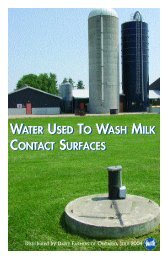Canadian Quality Milk On-Farm Food Safety Program - Centre ...
Canadian Quality Milk On-Farm Food Safety Program - Centre ...
Canadian Quality Milk On-Farm Food Safety Program - Centre ...
Create successful ePaper yourself
Turn your PDF publications into a flip-book with our unique Google optimized e-Paper software.
<strong>Canadian</strong> <strong>Quality</strong> <strong>Milk</strong><br />
Glossary<br />
Audit*<br />
Auditor*<br />
Word or Phrase<br />
Best Management<br />
Practices (BMPs)<br />
Definition<br />
A systematic, independent and documented process for obtaining audit<br />
evidence and evaluating it objectively to determine the extent to which audit<br />
criteria are fulfilled.<br />
A person with the competence to conduct an audit.<br />
BMPs are equivalent to prerequisite programs of HAACP and describe the<br />
production processes. The CQM program has 8 major BMP subject areas,<br />
which are:<br />
1. Dairy Facilities, Pesticides and Nutrient Management<br />
2. Feed<br />
3. Animal Health and Biosecurity<br />
4. Medicines and Chemicals Used on Livestock<br />
5. <strong>Milk</strong>ing Management<br />
6. Facility and Equipment Sanitation<br />
7. Use of Water for Cleaning <strong>Milk</strong> Contact Surfaces<br />
8. Staff Training and Communication<br />
Buffer tank<br />
Bulk tank<br />
Control (noun)<br />
Control (verb)<br />
Control Measures<br />
Corrective Actions*<br />
Refrigerated tank that receives and stores milk when the bulk tank is being<br />
emptied or washed and until it has collected a sufficient volume of milk to<br />
move back to bulk tank without freezing the milk.<br />
Primary refrigerated tank that receives and stores milk.<br />
The state wherein correct procedures are being followed and criteria are<br />
being met.<br />
To take all necessary actions to ensure and maintain compliance with criteria<br />
established in the HAACP plan.<br />
Actions and activities that can be used to prevent or eliminate a food safety<br />
hazard or reduce it to an acceptable level.<br />
Action to eliminate the cause of a detected nonconformity or other<br />
undesirable situation.<br />
Note 1: there can be more than one cause for a nonconformity.<br />
Note 2: Corrective action is taken to prevent recurrence whereas preventive<br />
action is taken to prevent occurrence.<br />
Note 3: There is a distinction between correction and corrective action.<br />
Critical Control Point<br />
(CCP)<br />
Critical Limit<br />
A point, step or procedure at which control can be applied and a food safety<br />
hazard can be prevented, eliminated or reduced to acceptable levels.<br />
A criterion which separates acceptability from unacceptability.<br />
12—2<br />
June 2010
















